GIS-Based Three-Dimensional SPH Simulation for the 11 April 2018 Yabakei Landslide at Oita Nakatsu, Japan
Abstract
1. Introduction
2. Characteristics of the Landslide Event
3. Triggering Factors of the Landslide Event
3.1. Geomorphology of the Area
3.2. Geology of the Area
3.3. Hydrology Condition
4. Triggering Mechanism Analysis
5. Dynamic Process Simulation Using SC-HBP-SPH Model
5.1. The Three-Dimensional HBP-SPH Method
5.2. Configuration of the Numerical Model
5.3. Analysis of Dynamic Simulation Results
5.4. Extraction of Landslide Impact Force Using SC-Based Method
6. Discussion
6.1. Limitations
6.2. Sensitivity Analysis of Impact Force
7. Conclusions
- (1)
- To explore the triggering mechanism of the event, information regarding the geo-morphology, geology, and hydrology conditions of this event were obtained. Key findings by Standard Gamma Ray (SGR) log are that four major internal fractures distributed in the slope body were identified, providing possible storages for perched groundwater. Groundwater stored in the internal fractures infiltrated through the permeable sand-stone.
- (2)
- It is speculated that abundant illite and askanite in the weathered sediment rocks swelled and broke when contacting the infiltrated groundwater, initiating the Yabakei land-slide event. Through the dynamic process analysis of the landslide event, there was a maximum value on the main sliding line. The strategy of landslide prevention also cannot neglect the damage formed during the landslide deposition process.
- (3)
- To reproduce the dynamic process of the 2018 Yabakei landslide event, we further applied the proposed three-dimensional, HBP-SPH method to simulate the landslide dynamic process. Buildings in the landslide area are covered by a set of surfaced cells (SC) to analyze the landslide mass impact to the residential buildings. The above method can solve the complex process of landslide impact in real-time, effectively and conveniently. Four monitoring points were set to record the temporal and spatial variation of landslide impact forces.
- (4)
- Results showed that the landslide impact force to the 2# and 3# residential building could be up towards 4224.89 kN and 1704.42 kN, respectively, indicating that these two buildings have a high risk for structural damage. Through dynamic process simulation of landslide and the solution of impact force, we provided a reference for the prevention and site selection of buildings.
Author Contributions
Funding
Institutional Review Board Statement
Informed Consent Statement
Data Availability Statement
Conflicts of Interest
References
- Petley, D.; Alcantara-Ayala, I.; Goudie, A.S. Landslide hazards. In Geomorphological Hazards and Disaster Prevention; Cambridge University Press: Cambridge, UK, 2010; pp. 63–74. [Google Scholar]
- Alexander, D.E. Vulnerability to landslides. In Landslide Hazard and Risk; Thomas, G., Malcolm, G.A., Michael, J.C., Eds.; John Wiley & Sons: New York, NY, USA, 2004; pp. 175–198. [Google Scholar]
- Fan, X.; Xu, Q.; Scaringi, G.; Dai, L.; Li, W.; Dong, X.; Zhu, X.; Pei, X.; Dai, K.; Havenith, H.-B. Failure mechanism and kinematics of the deadly June 24th 2017 Xinmo landslide, Maoxian, Sichuan, China. Landslides 2017, 14, 2129–2146. [Google Scholar] [CrossRef]
- Han, Z.; Li, Y.; Du, Y.; Wang, W.; Chen, G. Noncontact detection of earthquake-induced landslides by an enhanced image binarization method incorporating with Monte-Carlo simulation. Nat. Hazards Risk. 2018, 10, 219–241. [Google Scholar] [CrossRef]
- Xia, M.; Ren, G.M.; Yang, X.L. Mechanism of a catastrophic landslide occurred on May 12, 2019, Qinghai Province, China. Landslides 2020, 18, 707–720. [Google Scholar] [CrossRef]
- Petley, D. Global patterns of loss of life from landslides. Geology 2012, 40, 927–930. [Google Scholar] [CrossRef]
- Yoshimatsu, H.; Abe, S. A review of landslide hazards in Japan and assessment of their susceptibility using an analytical hierarchic process (AHP) method. Landslides 2006, 3, 149–158. [Google Scholar] [CrossRef]
- Wang, S. Coupling of earth’s endogenic and exogenic geological processes and origins on serious geological disasters. J. Eng. Geol. 2002, 10, 115–117. [Google Scholar]
- Zhang, Y.; Wang, J.; Xu, Q.; Chen, G.; X Zhao, J.; Zheng, L.; Han, Z.; Yu, P. DDA validation of the mobility of earthquake-induced landslides. Eng. Geol. 2015, 194, 38–51. [Google Scholar] [CrossRef]
- Cheng, D.; Cui, Y.; Su, F.; Jia, Y.; Choi, C.E. The characteristics of the Mocoa compound disaster event, Colombia. Landslides 2018, 15, 1223–1232. [Google Scholar] [CrossRef]
- Cogan, J.; Gratchev, I.; Wang, G. Rainfall-induced shallow landslides caused by ex-Tropical Cyclone Debbie, 31st March 2017. Landslides 2018, 15, 1215–1221. [Google Scholar] [CrossRef]
- Han, Z.; Wang, W.; Li, Y.; Huang, J.; Su, B.; Tang, C.; Chen, G.; Qu, X. An integrated method for rapid estimation of the valley incision by debris flows. Eng. Geol. 2018, 232, 34–45. [Google Scholar] [CrossRef]
- Wang, N.; Yao, Y. Characteristics and mechanism of landslides in loess during freezing and thawing periods in seasonally frozen ground regions. J. Disaster Prev. Mitig. Eng. 2008, 28, 163–166. [Google Scholar] [CrossRef]
- Runyan, C.W.; D’Odorico, P. Bistable dynamics between forest removal and landslide occurrence. Water Resour. Res. 2014, 50, 1112–1130. [Google Scholar] [CrossRef]
- Preuth, T.; Glade, T.; Demoulin, A. Stability analysis of a human-influenced landslide in eastern Belgium. Geomorphology 2010, 120, 38–47. [Google Scholar] [CrossRef]
- Sorbino, G.; Nicotera, M.V. Unsaturated soil mechanics in rainfall-induced flow landslides. Eng. Geol. 2013, 165, 105–132. [Google Scholar] [CrossRef]
- Polemio, M.; Petrucci, O. Landslides in Research, Theory and Practice; Thomas Telford: London, UK, 2000. [Google Scholar]
- Qiao, J.; Wu, C.; Li, X.; Fan, X.; He, S.; Tian, H.; Xu, C. Analysis on super large-scale landslide in Tiantai, Xuanhan, Sichuan. J. Mt. Sci 2005, 23, 458–461. [Google Scholar]
- Kwong, A.K.L.; Wang, M.; Lee, C.F.; Law, K.T. A review of landslide problems and mitigation measures in Chongqing and Hong Kong. Eng. Geol. 2004, 76, 27–39. [Google Scholar] [CrossRef]
- Zhao, Y.; Li, Y.; Zhang, L.; Wang, Q. Groundwater level prediction of landslide based on classification and regression tree. Geod. Geodyn. 2016, 7, 348–355. [Google Scholar] [CrossRef]
- Kim, D.H.; Gratchev, I.; Balasubramaniam, A. Determination of joint roughness coefficient (JRC) for slope stability analysis: A case study from the Gold Coast area, Australia. Landslides 2013, 10, 657–664. [Google Scholar] [CrossRef]
- Kim, D.H.; Gratchev, I.; Balasubramaniam, A. A Photogrammetric Approach for Stability Analysis of Weathered Rock Slopes. Geotech. Geol. Eng. 2014, 33, 443–454. [Google Scholar] [CrossRef]
- Shokouhi, A.; Gratchev, I.; Charrismanagara, A. Rock slope stability problems in Gold Coast area, Australia. Int. J. Geomate 2013, 4, 501–504. [Google Scholar]
- Kattel, P.; Kafle, J.; Fischer, J.-T.; Mergili, M.; Tuladhar, B.M.; Pudasaini, S.P. Interaction of two-phase debris flow with obstacles. Eng. Geol. 2018, 242, 197–217. [Google Scholar] [CrossRef]
- Mori, H.; Chen, X.; Leung, Y.F.; Shimokawa, D.; Lo, M.K. Landslide hazard assessment by smoothed particle hydrodynamics with spatially variable soil properties and statistical rainfall distribution. Can. Geotech. J. 2020, 57, 1953–1969. [Google Scholar] [CrossRef]
- Larese, A.; Rossi, R.; Oñate, E.; Idelsohn, S.R. Validation of the particle finite element method (PFEM) for simulation of free surface flows. Eng. Comput. 2008, 25, 385–425. [Google Scholar] [CrossRef]
- Lv, X.; Zou, Q.; Reeve, D. Numerical simulation of overflow at vertical weirs using a hybrid level set/VOF method. Adv. Water Resour. 2011, 34, 1320–1334. [Google Scholar] [CrossRef]
- Dai, Z.; Huang, Y.; Cheng, H.; Xu, Q. 3D numerical modeling using smoothed particle hydrodynamics of flow-like landslide propagation triggered by the 2008 Wenchuan earthquake. Eng. Geol. 2014, 180, 21–33. [Google Scholar] [CrossRef]
- Huang, Y.; Zhang, W.; Xu, Q.; Xie, P.; Hao, L. Run-out analysis of flow-like landslides triggered by the Ms 8.0 2008 Wenchuan earthquake using smoothed particle hydrodynamics. Landslides 2011, 9, 275–283. [Google Scholar] [CrossRef]
- Pastor, M.; Yague, A.; Stickle, M.M.; Manzanal, D.; Mira, P. A two-phase SPH model for debris flow propagation. Int. J. Numer. Anal. Methods Geomech. 2018, 42, 418–448. [Google Scholar] [CrossRef]
- Shao, S.; Lo, E.Y.M. Incompressible SPH method for simulating Newtonian and non-Newtonian flows with a free surface. Adv. Water Resour. 2003, 26, 787–800. [Google Scholar] [CrossRef]
- Wang, W.; Chen, G.; Han, Z.; Zhou, S.; Zhang, H.; Jing, P. 3D numerical simulation of debris-flow motion using SPH method incorporating non-Newtonian fluid behavior. Nat. Hazards 2016, 81, 1981–1998. [Google Scholar] [CrossRef]
- Paris, E.; Sciarra, N.; Minatti, L.; Pasculli, A. SPH modeling of fast muddy debris flow: Numerical and experimental comparison of certain commonly utilized approaches. Ital. J. Geosci. 2013, 132, 350–365. [Google Scholar] [CrossRef]
- Coussot, P.; Laigle, D.; Arattano, M.; Deganutti, A.; Marchi, L. Direct determination of rheological characteristics of debris flow. J. Hydraul. Eng. 1998, 124, 865–868. [Google Scholar] [CrossRef]
- Frigaard, I.A.; Nouar, C. On the usage of viscosity regularisation methods for visco-plastic fluid flow computation. J. Non-Newton. Fluid Mech. 2005, 127, 1–26. [Google Scholar] [CrossRef]
- Papanastasiou, T.C. Flows of Materials with Yield. J. Rheol. 1987, 31, 385–404. [Google Scholar] [CrossRef]
- Han, Z.; Su, B.; Li, Y.; Dou, J.; Wang, W.; Zhao, L. Modeling the progressive entrainment of bed sediment by viscous debris flows using the three-dimensional SC-HBP-SPH method. Water Res. 2020, 182, 116031. [Google Scholar] [CrossRef]
- Chambon, G.; Bouvarel, R.; Laigle, D.; Naaim, M. Numerical simulations of granular free-surface flows using smoothed particle hydrodynamics. J. Non-Newton. Fluid Mech. 2011, 166, 698–712. [Google Scholar] [CrossRef]
- Huang, Y.; Dai, Z. Large deformation and failure simulations for geo-disasters using smoothed particle hydrodynamics method. Eng. Geol. 2014, 168, 86–97. [Google Scholar] [CrossRef]
- Peng, X.; Yu, P.; Chen, G.; Xia, M.; Zhang, Y. Development of a Coupled DDA–SPH Method and its Application to Dynamic Simulation of Landslides Involving Solid–Fluid Interaction. Rock Mech. Rock Eng. 2019, 53, 113–131. [Google Scholar] [CrossRef]
- Xie, M.; Cai, M. The Theory and Practice of Information of Slope Engineering; Science Press: Beijing, China, 2005. [Google Scholar]
- Begueria, S.; Van Asch, T.W.J.; Malet, J.P.; Groendahl, S. A GIS-based numerical model for simulating the kinematics of mud and debris flows over complex terrain. Nat. Hazards Earth Syst. Sci. 2009, 9, 1897–1909. [Google Scholar] [CrossRef]
- Shahabi, H.; Hashim, M. Landslide susceptibility mapping using GIS-based statistical models and Remote sensing data in tropical environment. Sci. Rep. 2015, 5, 1–15. [Google Scholar] [CrossRef] [PubMed]
- Ishizuka, Y.; Ozaki, M.; Hoshizumi, H. Geological map of Japan 1:200000. 2009, AIST. NI-52-54.
- Yasufuku, N.; Yasuhiro, M. Influence of geological fractures on landslide using gamma ray testing. In Report of Yabakei landslide, Nakatsu, July 2018; Yasufuku, N., Yasuhiro, M., Eds.; Japanese Geotechnical Society: Tokyo, Japan, 2018; pp. 13–47. [Google Scholar]
- Hirakawa, Y.; Kashiwabara, Y.; Chiba, T.; Yamaguchi, K. Trial of Swift Estimation of Colluvial Volume in Collapsed Area after Landslide Disaster: Case of the Collapse at Yabakei, 11th April, 2018. Int. J. Eros. Control Eng. 2018, 71. [Google Scholar] [CrossRef]
- Che, V.B.; Kervyn, M.; Suh, C.E.; Fontijn, K.; Ernst, G.G.J.; del Marmol, M.A.; Trefois, P.; Jacobs, P. Landslide susceptibility assessment in Limbe (SW Cameroon): A field calibrated seed cell and information value method. Catena 2012, 92, 83–98. [Google Scholar] [CrossRef]
- Tsuchida, T.; Kano, S.; Nakagawa, S.; Kaibori, M.; Nakai, S.; Kitayama, N. Landslide and mudflow disaster in disposal site of surplus soil at Higashi-Hiroshima due to heavy rainfall in 2009. Soils Found. 2014, 54, 621–638. [Google Scholar] [CrossRef][Green Version]
- TAJIKA, J.; ISHIMARU, S.; WATANABE, T.; ISHIKAWA, I.; SHIMURA, K. Rockslide and avalanche on the cliff of welded tuff, Sounkyo gorge, Hokkaido, in September 2013. J. Jpn. Landslide Soc. 2015, 52, 146–151. [Google Scholar] [CrossRef][Green Version]
- Yamao, M.; Sidle, R.C.; Gomi, T.; Imaizumi, F. Characteristics of landslides in unwelded pyroclastic flow deposits, southern Kyushu, Japan. Nat. Hazards Earth Syst. Sci. 2016, 16, 617–627. [Google Scholar] [CrossRef]
- Durgin, P. Landslides and the weathering of granitic rocks. Rev. Eng. Geol. 1977, 3, 127–131. [Google Scholar]
- Regmi, A.D.; Yoshida, K.; Nagata, H.; Pradhan, A.M.S.; Pradhan, B.; Pourghasemi, H.R. The relationship between geology and rock weathering on the rock instability along Mugling–Narayanghat road corridor, Central Nepal Himalaya. Nat. Hazards 2012, 66, 501–532. [Google Scholar] [CrossRef]
- Chigira, M.; Wang, W.-N.; Furuya, T.; Kamai, T. Geological causes and geomorphological precursors of the Tsaoling landslide triggered by the 1999 Chi-Chi earthquake, Taiwan. Eng. Geol. 2003, 68, 259–273. [Google Scholar] [CrossRef]
- Han, Z.; Su, B.; Li, Y.; Wang, W.; Wang, W.; Huang, J.; Chen, G. Numerical simulation of debris-flow behavior based on the SPH method incorporating the Herschel-Bulkley-Papanastasiou rheology model. Eng. Geol. 2019, 255, 26–36. [Google Scholar] [CrossRef]
- Crespo, A.J.C.; Domínguez, J.M.; Rogers, B.D.; Gómez-Gesteira, M.; Longshaw, S.; Canelas, R.; Vacondio, R.; Barreiro, A.; García-Feal, O. DualSPHysics: Open-source parallel CFD solver based on Smoothed Particle Hydrodynamics (SPH). Comput. Phys. Commun. 2015, 187, 204–216. [Google Scholar] [CrossRef]
- Zhang, W.; Ji, J.; Gao, Y.; Li, X.; Zhang, C. Spatial variability effect of internal friction angle on the post-failure behavior of landslides using a random and non-Newtonian fluid based SPH method. Geosci. Front. 2020, 11, 1107–1121. [Google Scholar] [CrossRef]
- Zhang, W.; Zheng, H.; Jiang, F.; Wang, Z.; Gao, Y. Stability analysis of soil slope based on a water-soil-coupled and parallelized Smoothed Particle Hydrodynamics model. Comput. Geotech. 2019, 108, 212–225. [Google Scholar] [CrossRef]
- Monaghan, J.J. Smoothed particle hydrodynamics. Annu. Rev. Astron. Astrophys. 1992, 30, 543–574. [Google Scholar] [CrossRef]
- Bui, H.H.; Fukagawa, R.; Sako, K.; Ohno, S. Lagrangian meshfree particles method (SPH) for large deformation and failure flows of geomaterial using elastic-plastic soil constitutive model. Int. J. Numer. Anal. Methods Geomech. 2008, 32, 1537–1570. [Google Scholar] [CrossRef]
- Monaghan, J.J.; Kos, A. Solitary Waves on a Cretan Beach. J. Waterw. Port Coast. Ocean Eng. 1999, 125, 145–155. [Google Scholar] [CrossRef]
- Canelli, L.; Ferrero, A.M.; Migliazza, M.; Segalini, A. Debris flow risk mitigation by the means of rigid and flexible barriers—experimental tests and impact analysis. Nat. Hazards Earth Syst. Sci. 2012, 12, 1693–1699. [Google Scholar] [CrossRef]
- Hungr, O.; Morgan, G.; Kellerhals, R. Quantitative analysis of debris torrent hazards for design of remedial measures: Hungr, O.; Morgan, G C.; Kellerhals, R Can Geotech JV21, N4, Nov 1984, P663–677. Int. J. Rock Mech. Min. Sci. Geomech. Abstr. 1984, 22, 129. [Google Scholar] [CrossRef]
- Li, S.; Peng, C.; Wu, W.; Wang, S.; Chen, X.; Chen, J.; Zhou, G.G.D.; Chitneedi, B.K. Role of baffle shape on debris flow impact in step-pool channel: An SPH study. Landslides 2020. [Google Scholar] [CrossRef]
- Zhang, S. Comprehensive Approach to the Observation and Prevention of Debris Flows in China. Nat. Hazards 1993, 7, 1–23. [Google Scholar] [CrossRef]
- Hu, K.; Wei, F.; Li, Y. Real-time measurement and preliminary analysis of debris-flow impact force at Jiangjia Ravine, China. Earth Surf. Process. Landforms. 2011, 36, 1268–1278. [Google Scholar] [CrossRef]
- Canelas, R.B.; Crespo, A.J.C.; Domínguez, J.M.; Ferreira, R.M.L.; Gómez-Gesteira, M. SPH–DCDEM model for arbitrary geometries in free surface solid–fluid flows. Comput. Phys. Commun. 2016, 202, 131–140. [Google Scholar] [CrossRef]
- Canelas, R.B.; Domínguez, J.M.; Crespo, A.J.C.; Gómez-Gesteira, M.; Ferreira, R.M.L. A Smooth Particle Hydrodynamics discretization for the modelling of free surface flows and rigid body dynamics. Int. J. Numer. Methods Fluids 2015, 78, 581–593. [Google Scholar] [CrossRef]
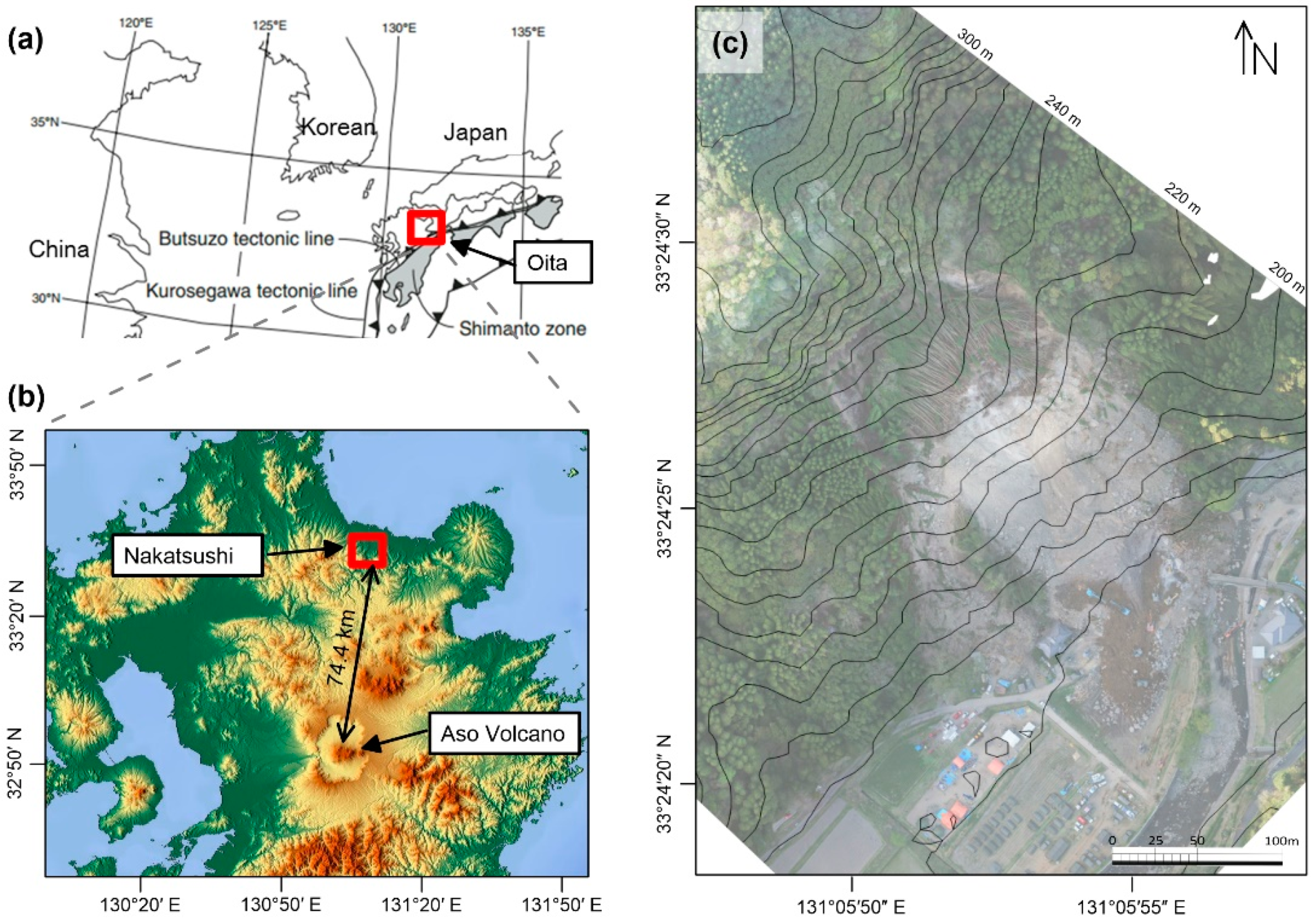
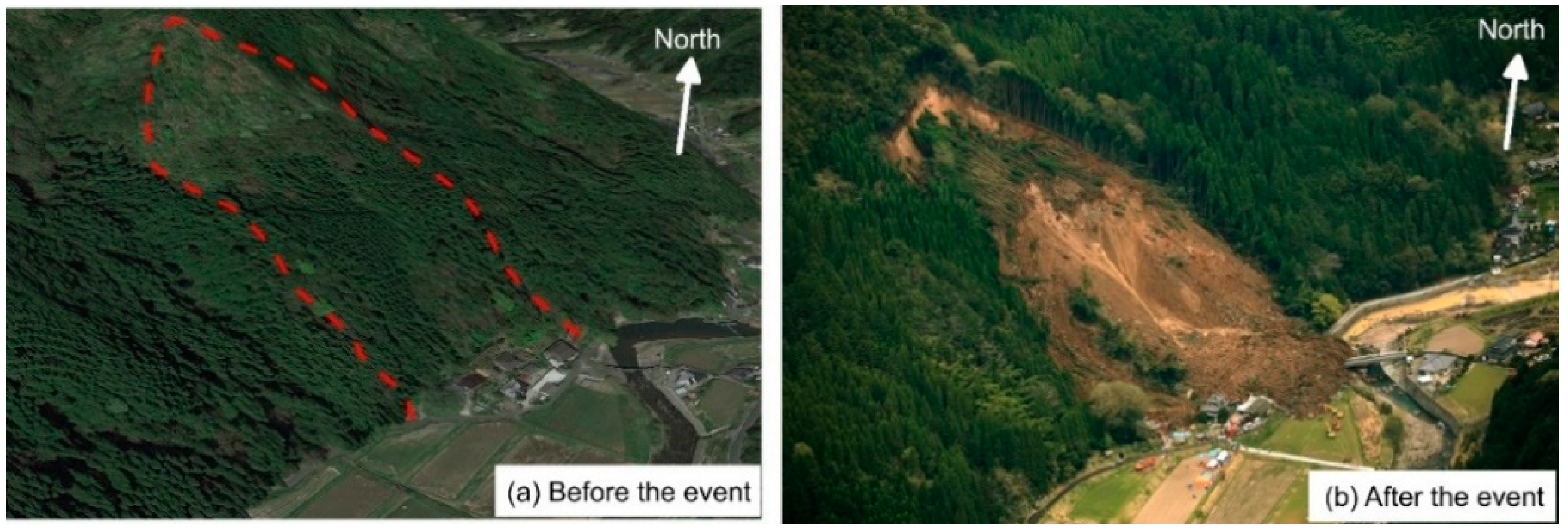
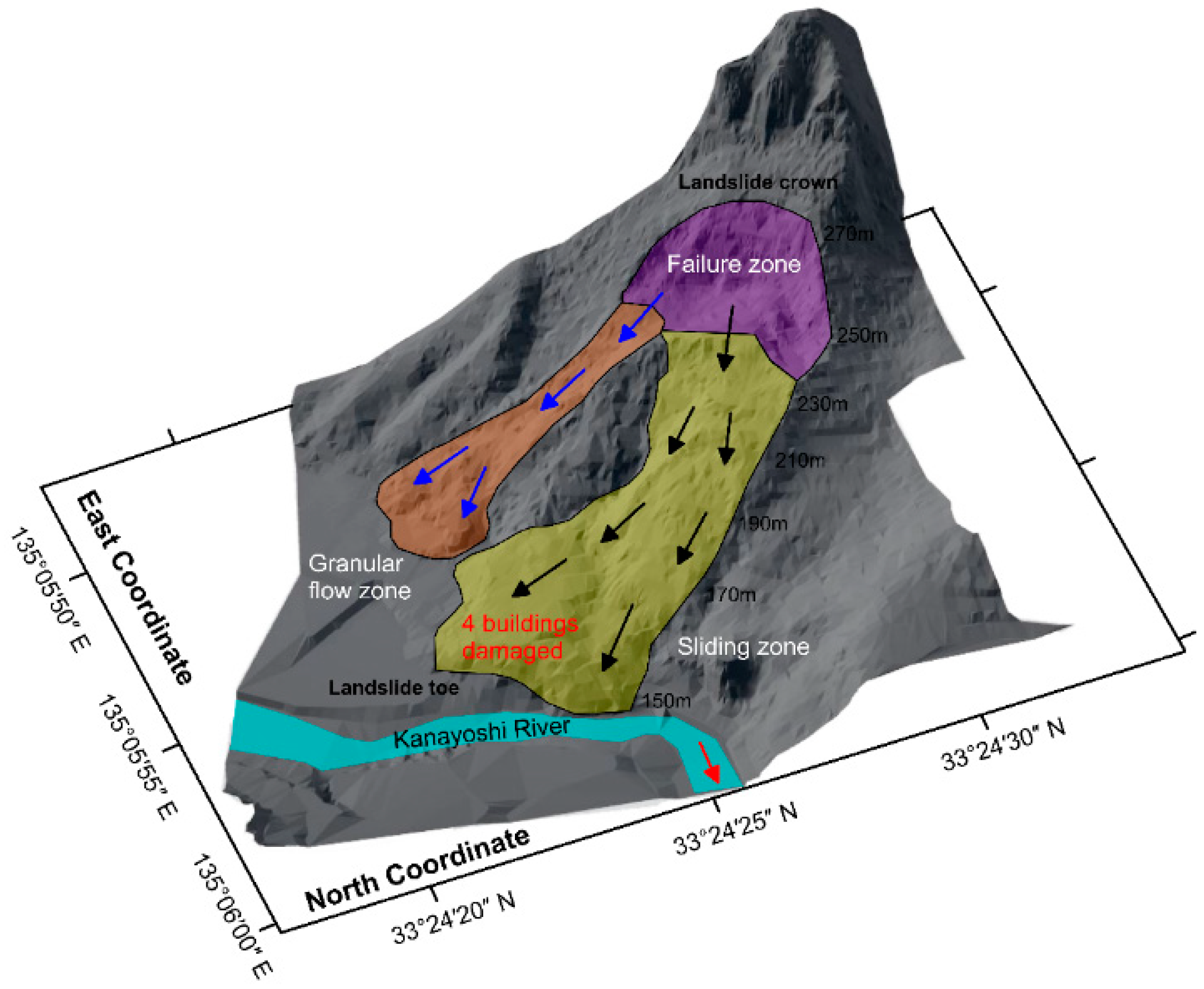
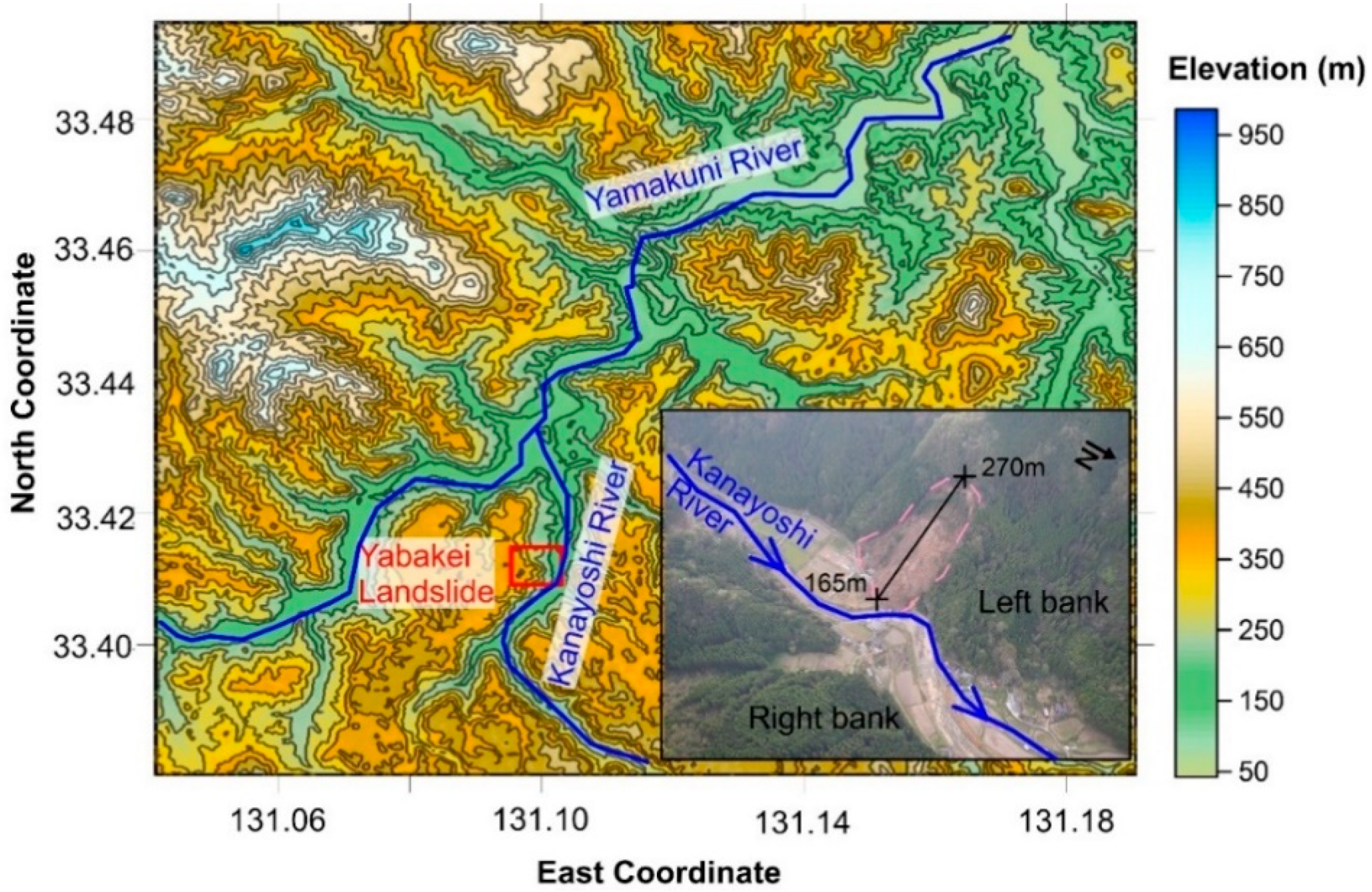

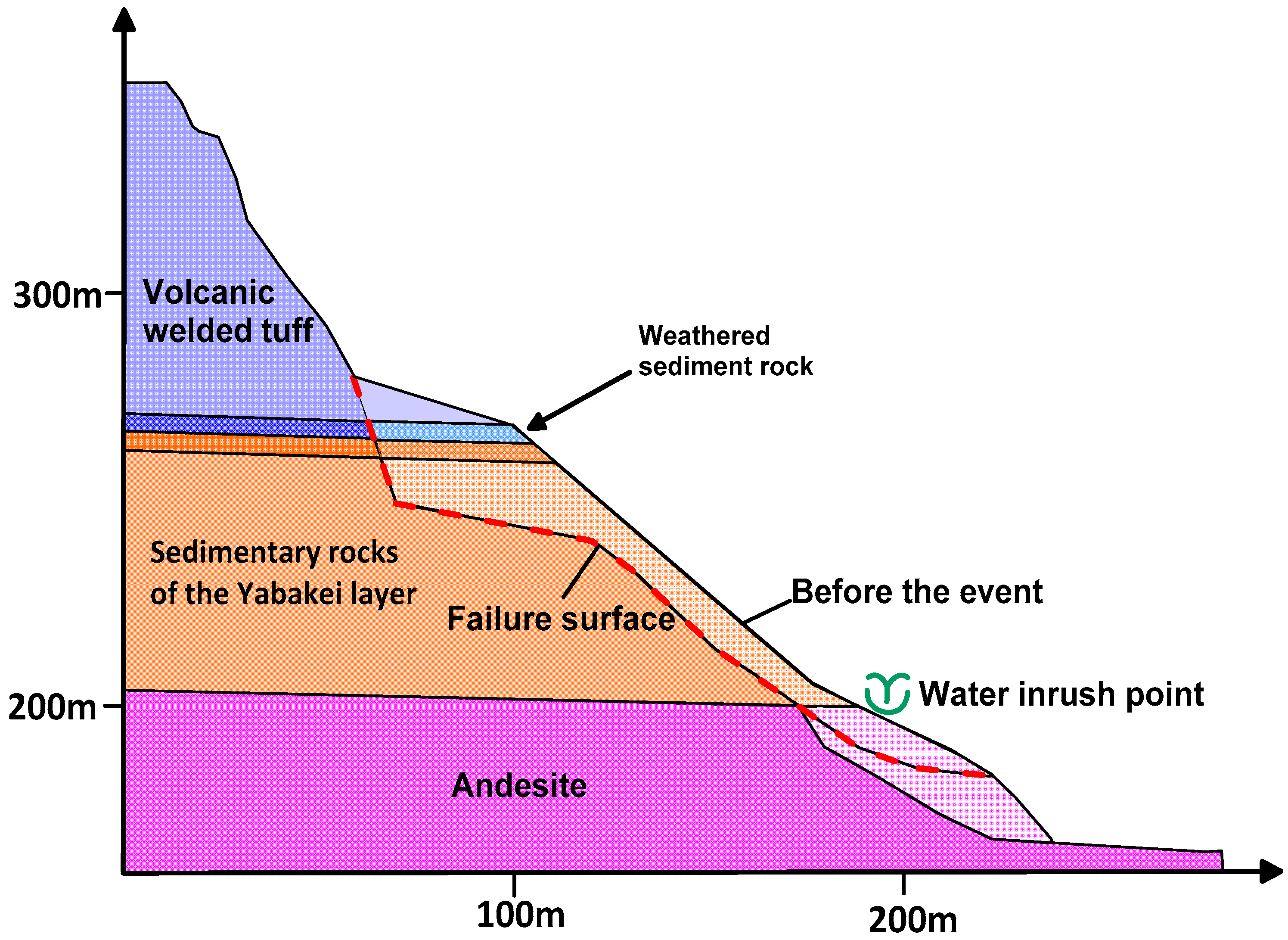



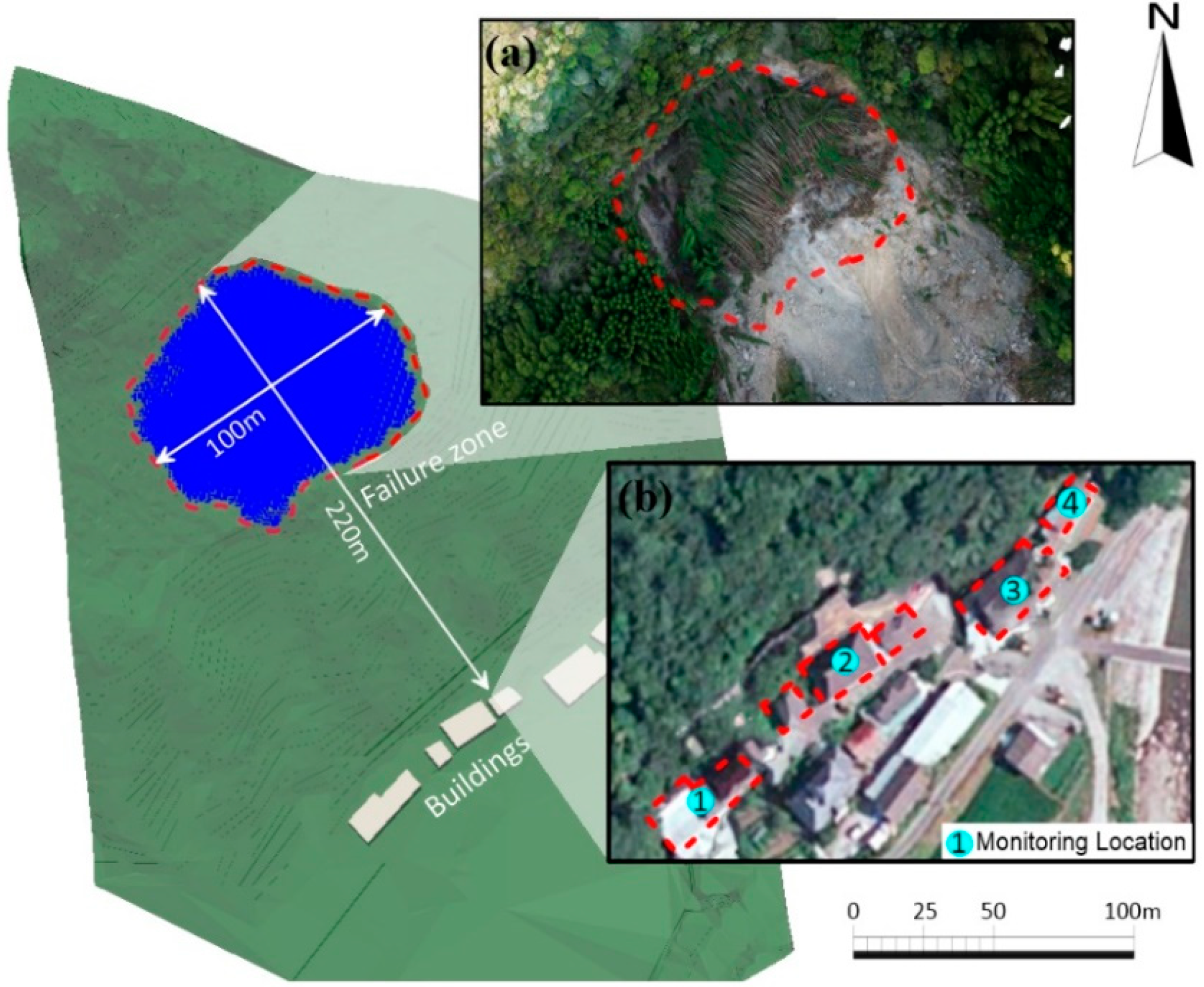
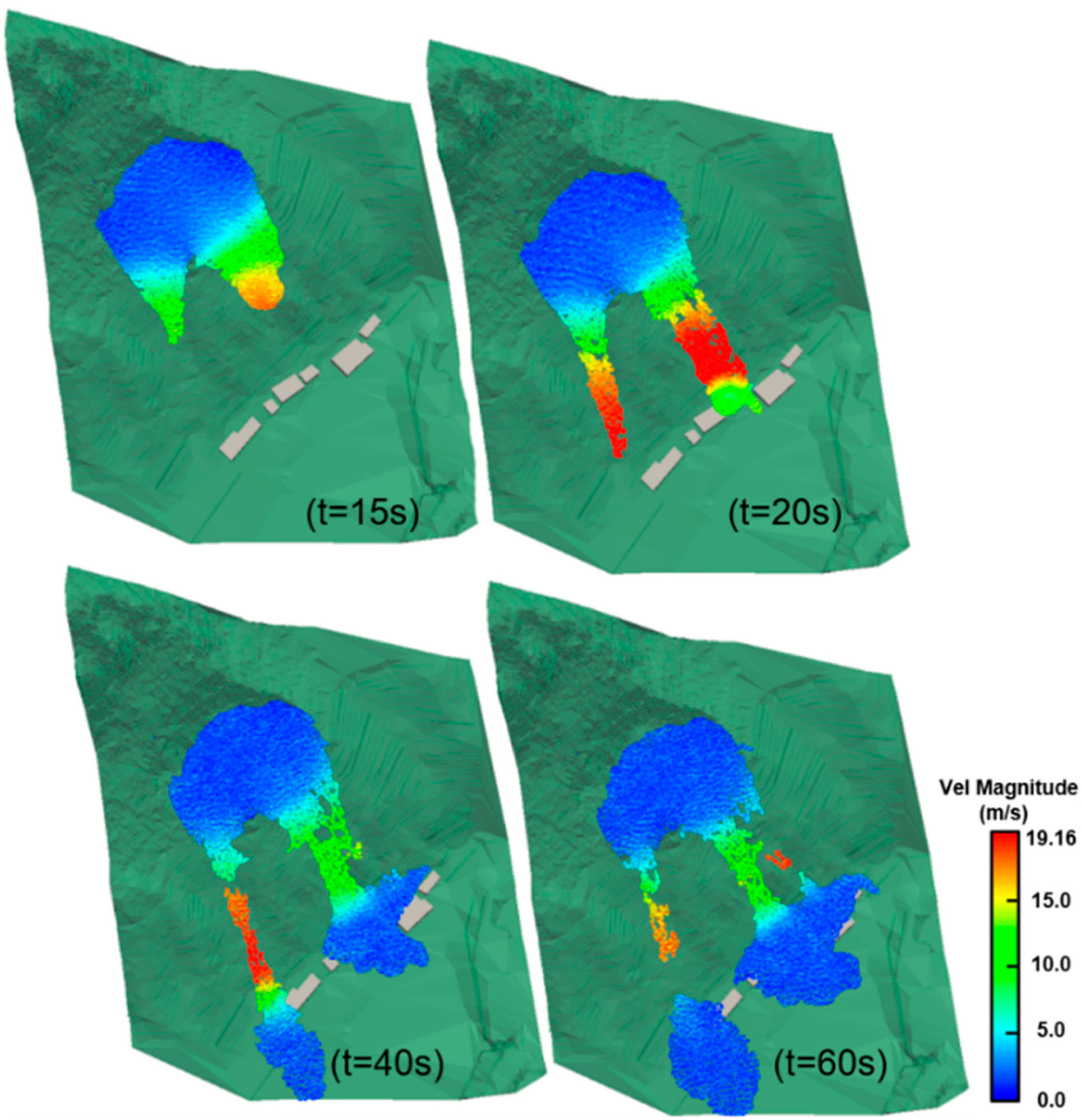
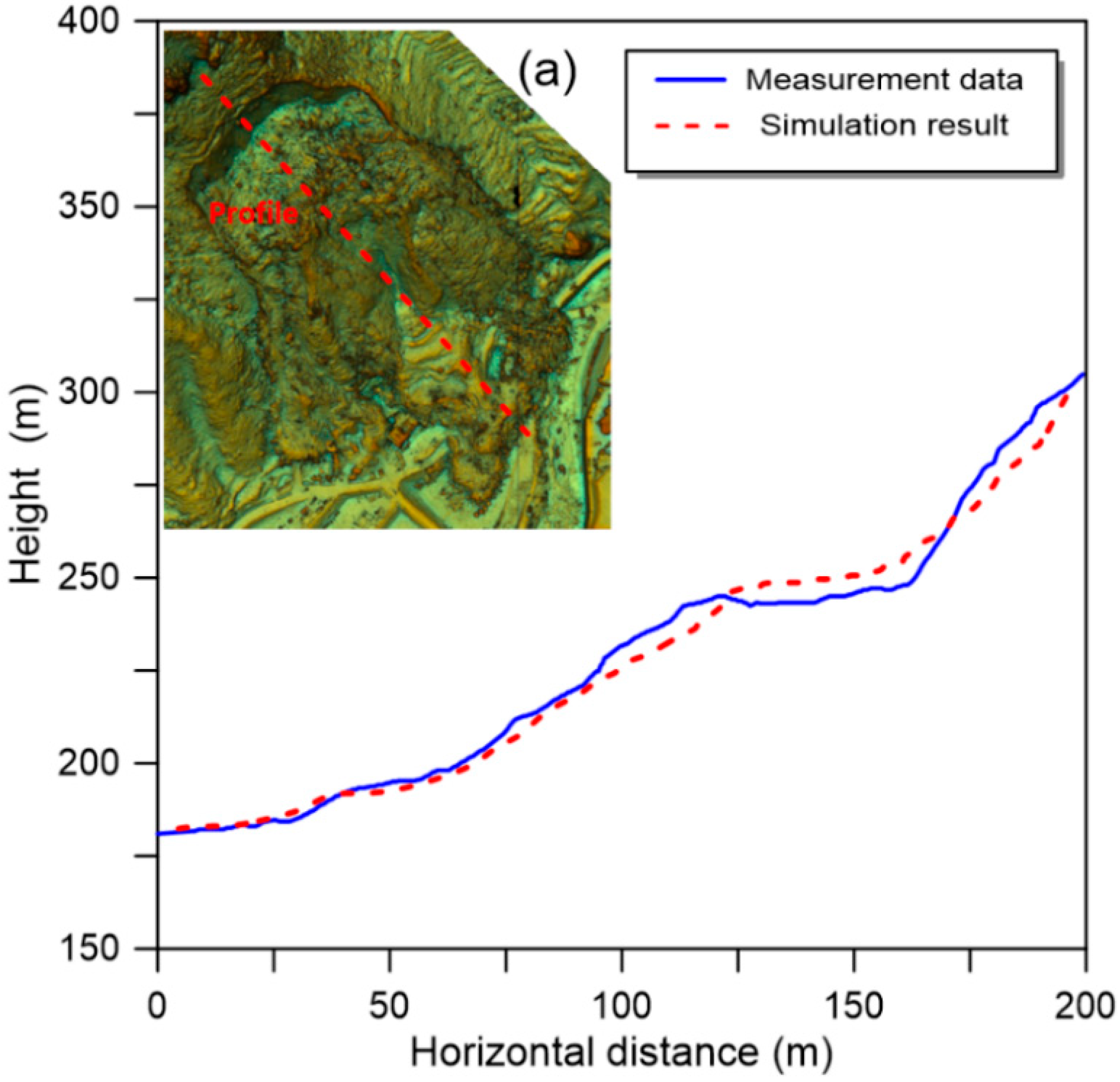
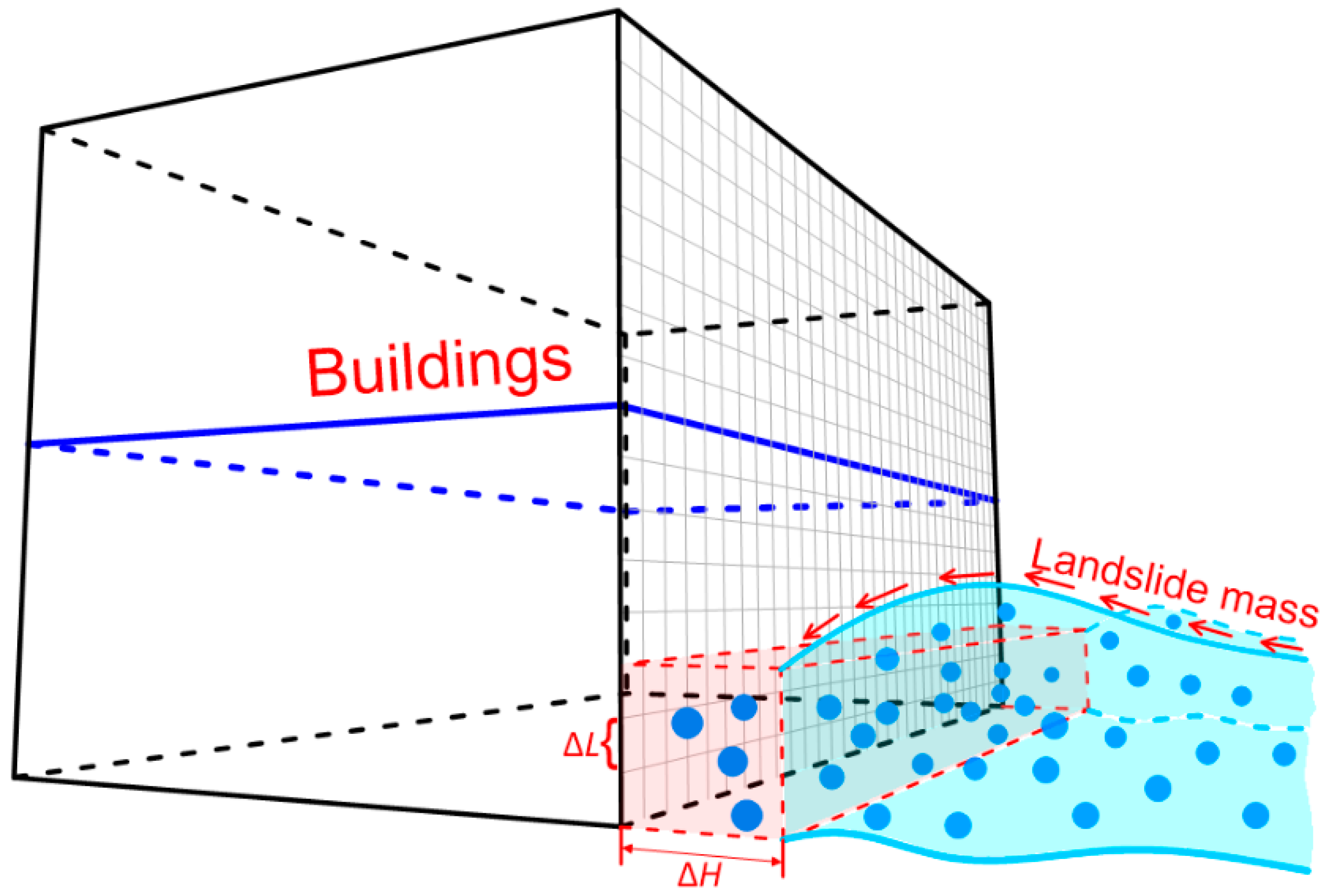
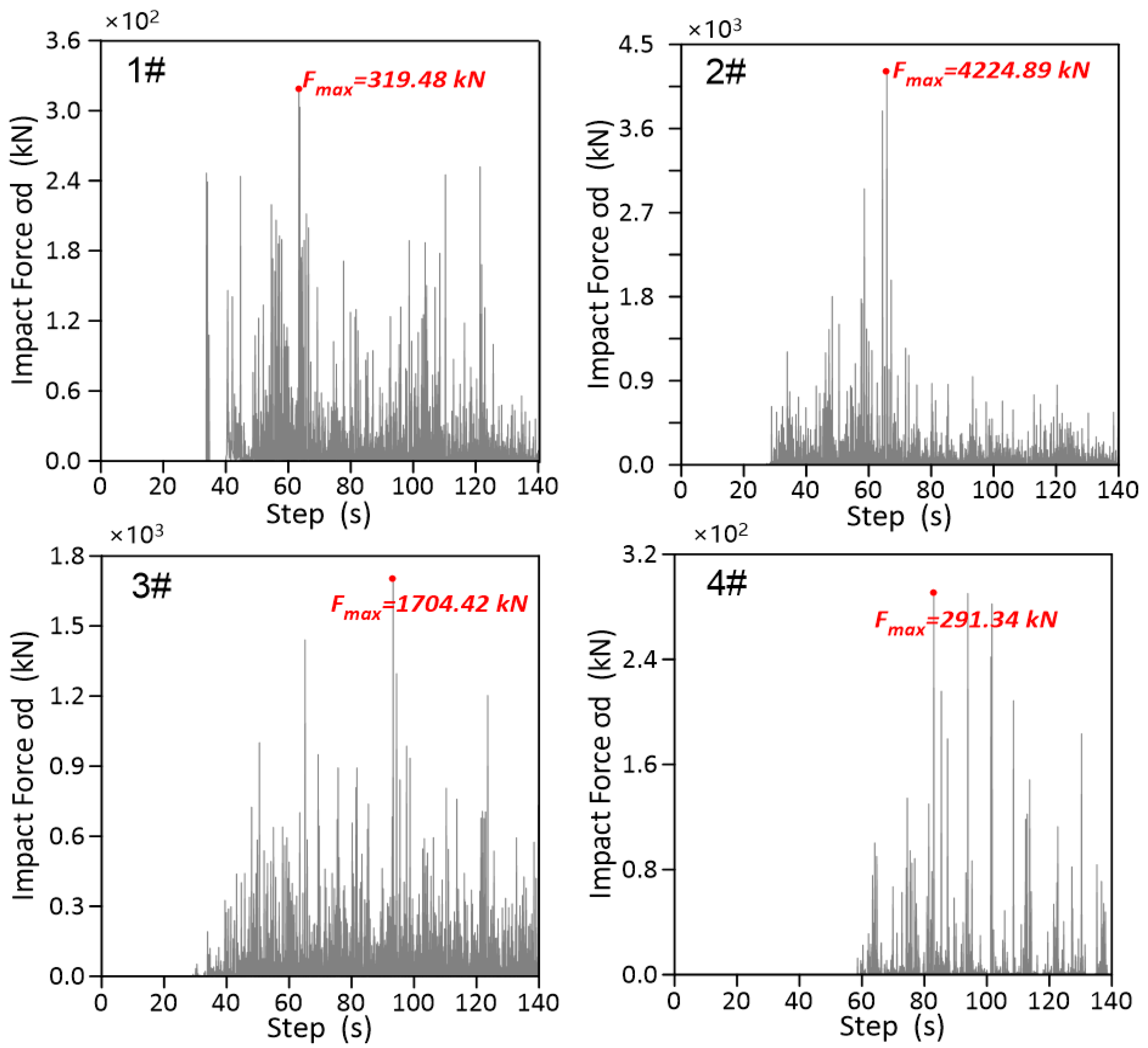

| Parameter | Notation | Unit | Value |
|---|---|---|---|
| Density | kg/m3 | 1730 | |
| Apparent dynamic viscosity | Pa·s | 0.001 | |
| Yield strength 1 | Pa | 0 | |
| ° | 40 | ||
| Key coefficients of HBP model | / | 100 | |
| n | / | 1.00 | |
| Total number of fluid particles | / | 44,974 | |
| Total number of boundary particles | / | 10,987 | |
| Particle distance | m | 1.0 | |
| Smoothing length | m | 1.732 | |
| Artificial viscosity coefficient | / | 0.1 | |
| EoS constant | / | 7 | |
| Initial time interval | s | 0.0001 | |
| CFL coefficient | / | 0.2 | |
| Simulation duration | t | s | 1400 |
| Parameters | Notation | Unit | Value |
|---|---|---|---|
| The empirical correction coefficient of impact force formula | / | 3.0 | |
| Distance of impact contact surface | m | 2.0 | |
| Size of the SC | m | 0.5 | |
| Landslide duration | s | 1400 | |
| Time increment | s | 0.1 |
Publisher’s Note: MDPI stays neutral with regard to jurisdictional claims in published maps and institutional affiliations. |
© 2021 by the authors. Licensee MDPI, Basel, Switzerland. This article is an open access article distributed under the terms and conditions of the Creative Commons Attribution (CC BY) license (https://creativecommons.org/licenses/by/4.0/).
Share and Cite
Han, Z.; Yang, F.; Li, Y.; Dou, J.; Chen, N.; Hu, G.; Chen, G.; Xu, L. GIS-Based Three-Dimensional SPH Simulation for the 11 April 2018 Yabakei Landslide at Oita Nakatsu, Japan. Water 2021, 13, 3012. https://doi.org/10.3390/w13213012
Han Z, Yang F, Li Y, Dou J, Chen N, Hu G, Chen G, Xu L. GIS-Based Three-Dimensional SPH Simulation for the 11 April 2018 Yabakei Landslide at Oita Nakatsu, Japan. Water. 2021; 13(21):3012. https://doi.org/10.3390/w13213012
Chicago/Turabian StyleHan, Zheng, Fan Yang, Yange Li, Jie Dou, Ningsheng Chen, Guisheng Hu, Guangqi Chen, and Linrong Xu. 2021. "GIS-Based Three-Dimensional SPH Simulation for the 11 April 2018 Yabakei Landslide at Oita Nakatsu, Japan" Water 13, no. 21: 3012. https://doi.org/10.3390/w13213012
APA StyleHan, Z., Yang, F., Li, Y., Dou, J., Chen, N., Hu, G., Chen, G., & Xu, L. (2021). GIS-Based Three-Dimensional SPH Simulation for the 11 April 2018 Yabakei Landslide at Oita Nakatsu, Japan. Water, 13(21), 3012. https://doi.org/10.3390/w13213012









